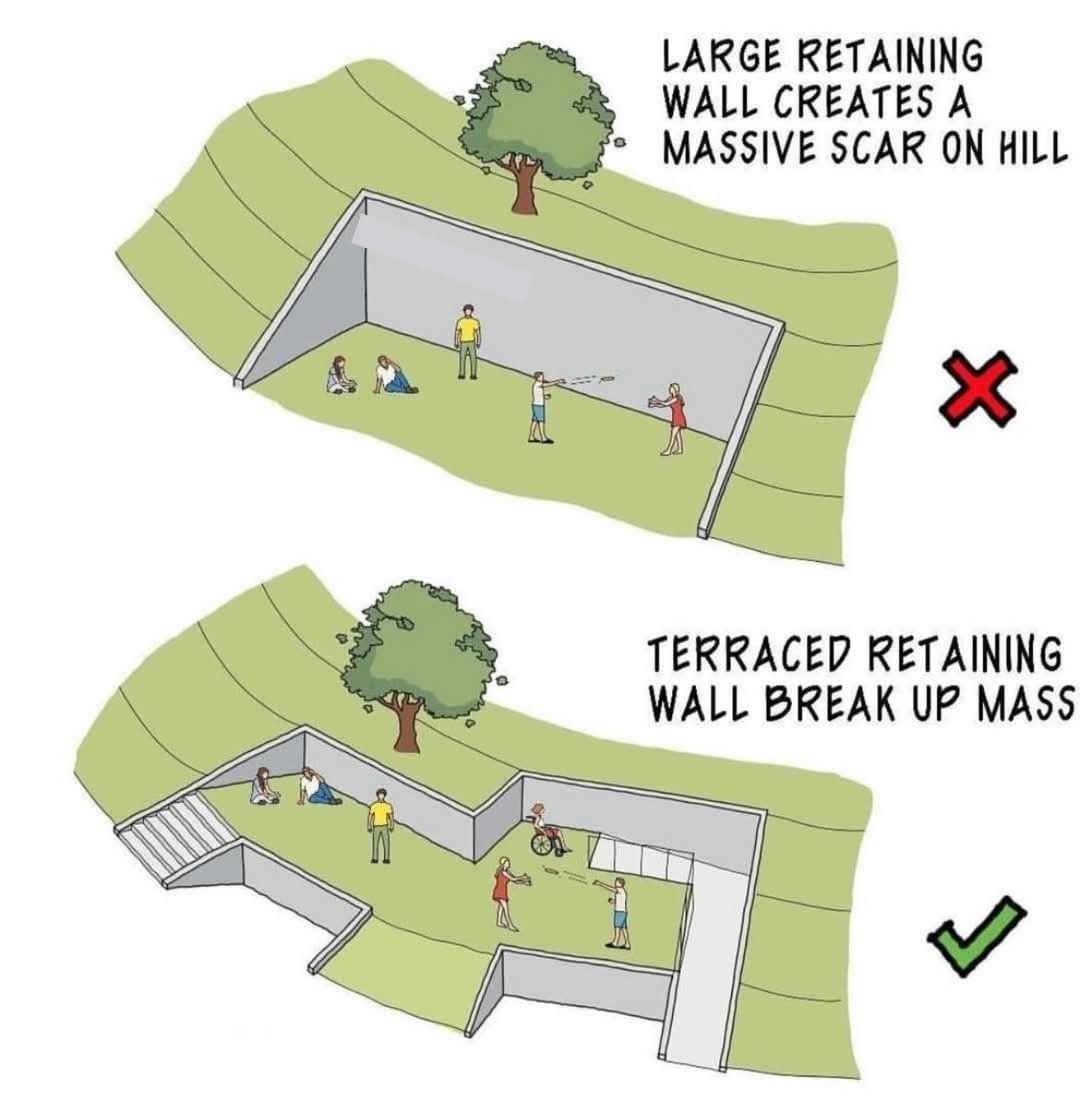From scarring the land to creating usable green terraces — how thoughtful retaining wall design is transforming landscapes and communities.
🌍 The Hillside Challenge
Hillsides are among nature’s most beautiful features, yet they present serious challenges for human settlement and development. Steep slopes are prone to erosion, water runoff, and instability, requiring engineered solutions to make the land safe and usable.
The most common tool for tackling these challenges has long been the retaining wall — a structure built to hold soil in place and create level ground for homes, gardens, or recreational areas. But while retaining walls solve one problem, they can create another: visual and environmental scars on the landscape.
❌ The Problem with Large Retaining Walls
Imagine a single, massive concrete wall cutting across a hillside. It may hold the earth in place, but it also disrupts the natural slope, creates a monolithic eyesore, and makes the land feel harsh and uninviting.
Large walls:
- Visually dominate the hillside, making natural beauty disappear.
- Interrupt water drainage, often causing erosion elsewhere.
- Limit usability, because the steep wall creates a barrier rather than a functional space.
- Increase maintenance costs, since big walls endure more structural pressure over time.
In short, while they achieve stability, they do so at the cost of aesthetics, ecology, and livability.
✅ The Terraced Solution
The alternative, shown in the lower half of the image, is terraced retaining walls. Instead of one giant wall, the hillside is supported by a series of smaller, stepped walls, breaking up the slope into usable flat platforms.
Advantages of Terraced Retaining Walls:
- Blended with Nature – Smaller walls follow the hillside’s natural contours, reducing the appearance of scarring.
- Functional Spaces – Each terrace creates level ground for gardens, seating, children’s play areas, or even bike storage.
- Improved Drainage – Terraces allow rainwater to filter naturally, reducing the risk of erosion.
- Eco-Friendly Design – Trees and plants can be incorporated into each terrace, integrating green life into the structure.
- Social and Recreational Benefits – Instead of a barren wall, communities gain usable outdoor spaces that invite interaction and play.
This design transforms retaining walls from a necessary evil into a positive architectural feature.
🏡 A Case Study in Human-Centered Design
The illustration shows two scenarios:
- In the top image, children play against a towering concrete wall, their activity confined and overshadowed by the looming structure. The wall dominates the environment, leaving little room for creativity or comfort.
- In the bottom image, the same hillside is terraced into smaller, human-scale spaces. Families enjoy multiple levels — one child rides a bicycle, another plays ball, while adults relax in open areas. The space feels natural, safe, and welcoming.
This difference highlights a critical principle in architecture and urban planning: design should serve people, not just engineering needs.
🌱 Environmental Benefits
Beyond aesthetics, terraced retaining walls offer significant environmental advantages.
- Erosion Control: By breaking the slope into smaller steps, rainwater slows down, reducing soil erosion.
- Groundwater Recharge: Terraces allow more water to soak into the soil instead of rushing away as surface runoff.
- Tree Preservation: Unlike massive walls that often require clearing vegetation, terraces can be built around existing trees, keeping ecosystems intact.
- Microclimates: Each level can host plants, shrubs, and gardens that cool the air and provide habitats for local wildlife.
This approach not only stabilizes the hill but also helps restore ecological balance.
💰 Economic and Social Value
It’s easy to see retaining walls as purely functional, but their design has real impacts on property value and community well-being.
- Property Appeal: Homes with terraced yards often sell for more because they offer usable outdoor living space.
- Community Engagement: Public terraces in parks or urban areas encourage social activities like walking, picnics, and gatherings.
- Cost Efficiency: Though initial construction may be slightly more complex, terraced walls often require less long-term repair compared to one massive wall under constant soil pressure.
In this way, thoughtful wall design becomes not just an engineering solution but a community investment.
🔧 How Terraced Walls Are Built
Building terraced retaining walls involves careful planning and engineering:
- Survey and Design – Engineers study the slope, soil type, and water flow to design terraces that blend with natural contours.
- Step Construction – Instead of digging out one large pad, the hillside is cut into smaller steps.
- Wall Installation – Each terrace is supported by smaller walls made of stone, concrete, or eco-friendly materials.
- Drainage Systems – Pipes, gravel, and vegetation are added to manage water flow.
- Landscaping – Terraces are finished with grass, gardens, or recreational features for community use.
This combination of engineering and landscaping ensures walls that are both strong and beautiful.
🌏 Global Relevance
Terraced walls are not a new invention — they echo the ancient agricultural terraces of Asia, South America, and the Mediterranean. Civilizations like the Inca and the Ifugao of the Philippines built terraced hillsides not only to farm steep land but also to live in harmony with nature.
Today, as cities expand into hillside regions, modern engineering is rediscovering this timeless wisdom: smaller, integrated steps are better than one massive intervention.
📰 Conclusion
The choice between a large retaining wall and terraced retaining walls is more than just a construction decision — it’s a statement about how we value nature, people, and the future of our landscapes.
- Large walls may hold back the soil, but they scar the land and limit human connection to space.
- Terraced walls, by contrast, stabilize slopes while adding value, beauty, and function to the environment.
In an era where sustainable design is becoming essential, the terraced approach shows us that practical engineering and ecological harmony can go hand in hand.
As the lower half of the image reminds us: the best walls are not those that divide us from nature, but those that help us live with it. 🌱
